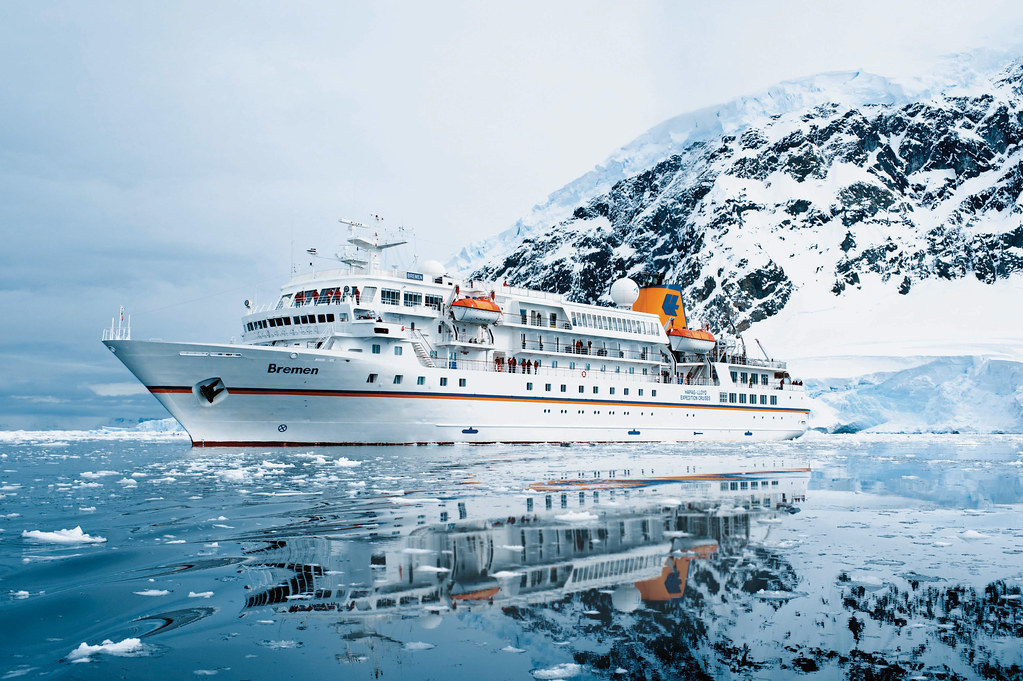#expeditioncruising .
Update: see below
The introduction of the new Polar Code requirements for all maritime traffic in the regions of the Arctic and Antarctic waters is about to have a much greater impact on expedition cruising than many people in the industry may realise, claims longtime cruise professional, Gerd Wilmer of Sydney’s Landmark Travel.
“Many ships currently operating on polar cruises and more intending to may not have fully realised the implications of the Polar Code on their forward plans,” says Wilmer, whose specialist cruise agency has operated for almost 40 years in the Sydney suburb of Manly.
 |
| Hapag-Lloyd's Bremen is one of the first vessels to become Polar Code compliant. |
The Polar Code in its entirety is a complicated technical document, but the most relevant section as far as expedition cruising is concerned means that vessels that do not currently have an Ice Rating of either 1A or 1A Super (see comments below) will not be permitted to operate below 60deg south or above 60deg north latitudes (with the exception of Iceland and Norwegian coast). Specifically this means Svalbard, Greenland and all of the Northwest Passage will require Polar Code compliant vessels. In the south, the entire Antarctic continent, including the Peninsula, requires this.
“There are one or two cruise lines who are advertising departures that, according to the code, will not be permitted on the dates advertised,” says Wilmer, “this may well cause some customer confusion and disappointment down the line.
“What is also most interesting is that many of these new, supposedly hi-tech ships under construction will not be certified under the Polar Code because of their light Ice Rating.”
 |
| Northern Polar Zone |
 |
| Southern Polar Zone |
The first implementation of the Polar Code came into force in January this year (2017) and second phase comes into force in January 2018. It states:
- Ships constructed on or after 1 January 2017 shall comply with the safety part of Polar Code at delivery.
- Ships constructed before 1 January 2017 shall comply with the safety part of the Polar Code by the first intermediate or renewal survey, whichever occurs first, after 1 January 2018. (renewal surveys take place at 5 year intervals)
So, from January 2018, Wilmer says we can expect to see some major reassignment of vessels currently enjoying their last taste of the ice.
NOTE: There is some discussion about whether an upgraded vessel can be deemed to be ‘new’ at time of application, plus there are also discussions about permitting certain non-compliant vessels into areas deemed ‘low risk’ around the Antarctic Peninsula. This article will be updated when these matters are clear.
NOTE: There is some discussion about whether an upgraded vessel can be deemed to be ‘new’ at time of application, plus there are also discussions about permitting certain non-compliant vessels into areas deemed ‘low risk’ around the Antarctic Peninsula. This article will be updated when these matters are clear.
"We (IAATO) have been involved right from the beginning of the code’s development and have held workshops for our members to get them ‘Polar Code Ready’."
Lynnes includes these notes for reference.
There is no restriction in the polar code requiring a 1A or 1A super - even if you look at the Polar Code which defines three categories of vessels (type A, B en C).
So no ship is excluded if it’s less than a 1A or 1A super, as long as the procedures and documents and certification are being met.
Operating in the Polar Waters depends on the Operating Envelope for the vessel, the operational assessment and an ice-risk system to be used, together with the PWOM (Polar Waters Operation Manual).
For existing ships there is no requirement to upgrade hull construction. The Polar Code Chapter 3, ships structure, clearly states “a category C ship need not be ice strengthened if, in the opinion of the administration, the ship’s structure is adequate for its intended operation.”
In response, Gerd Wilmer remains unconvinced.
"[IAATO] seems to think that some cruises will be able to use this clause* to operate inferior ships.
This will be very risky. As you know, cruises are planned 18 - 24 months before departure. I read the clause that Cat C ships will be allowed on an ad-hoc basis, taking into consideration current conditions."
- Type A means designed for operation in Polar Waters in at least medium first-year ice, which may include old ice inclusions
- Type B means designed for operations in Polar waters in at least thin first-year ice, which may include old ice inclusions
- Type C is designed to operate in conditions less then Type A / B.
So no ship is excluded if it’s less than a 1A or 1A super, as long as the procedures and documents and certification are being met.
Operating in the Polar Waters depends on the Operating Envelope for the vessel, the operational assessment and an ice-risk system to be used, together with the PWOM (Polar Waters Operation Manual).
For existing ships there is no requirement to upgrade hull construction. The Polar Code Chapter 3, ships structure, clearly states “a category C ship need not be ice strengthened if, in the opinion of the administration, the ship’s structure is adequate for its intended operation.”
In response, Gerd Wilmer remains unconvinced.
"[IAATO] seems to think that some cruises will be able to use this clause* to operate inferior ships.
This will be very risky. As you know, cruises are planned 18 - 24 months before departure. I read the clause that Cat C ships will be allowed on an ad-hoc basis, taking into consideration current conditions."
* "These ships may be intended for open water or very light ice conditions and don’t necessarily need to be ice-strengthened."
Ref: Polar Code Guide

No comments:
Post a Comment